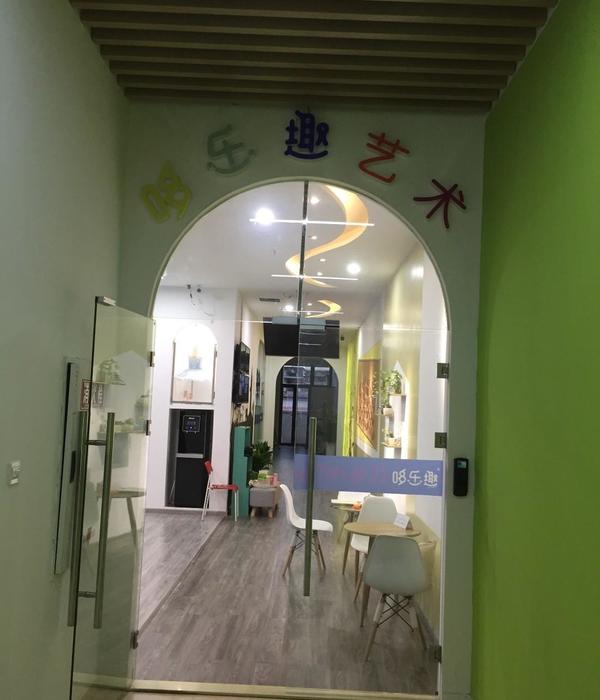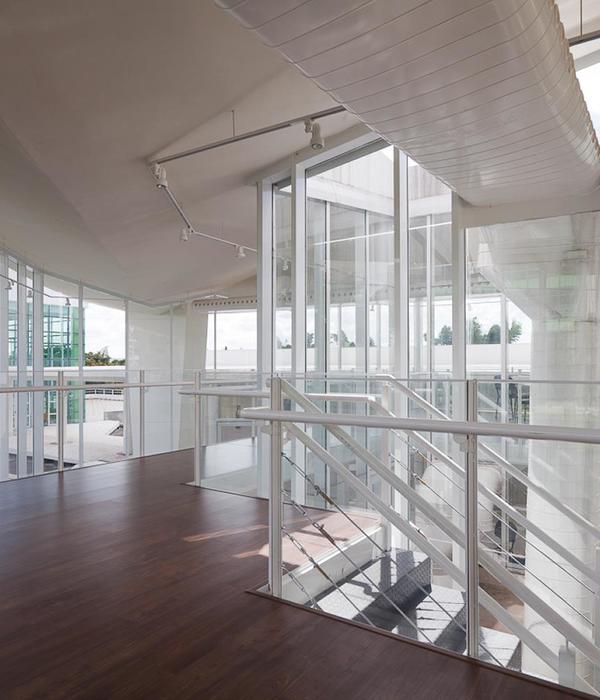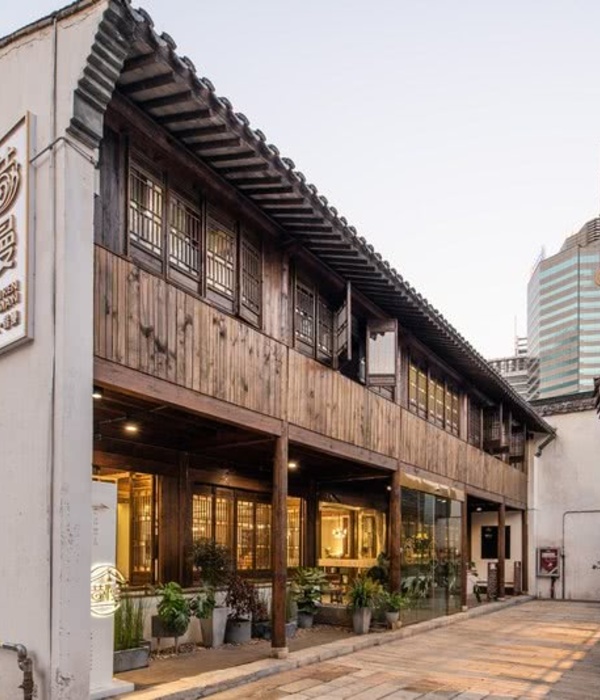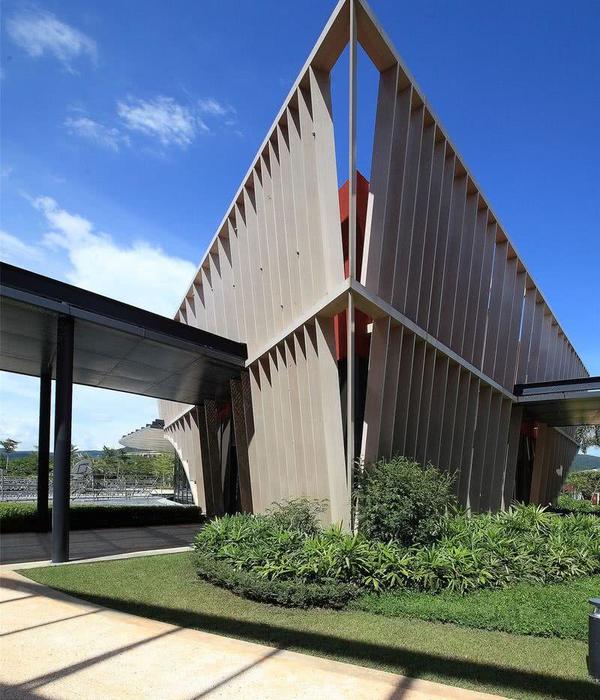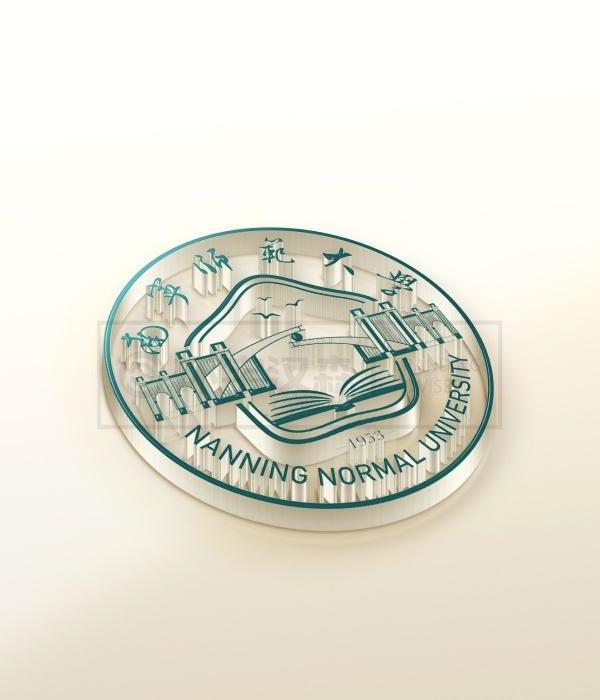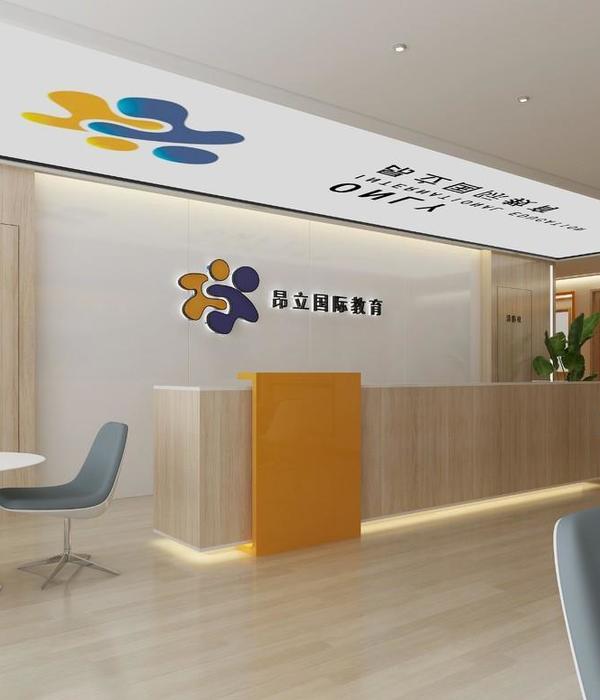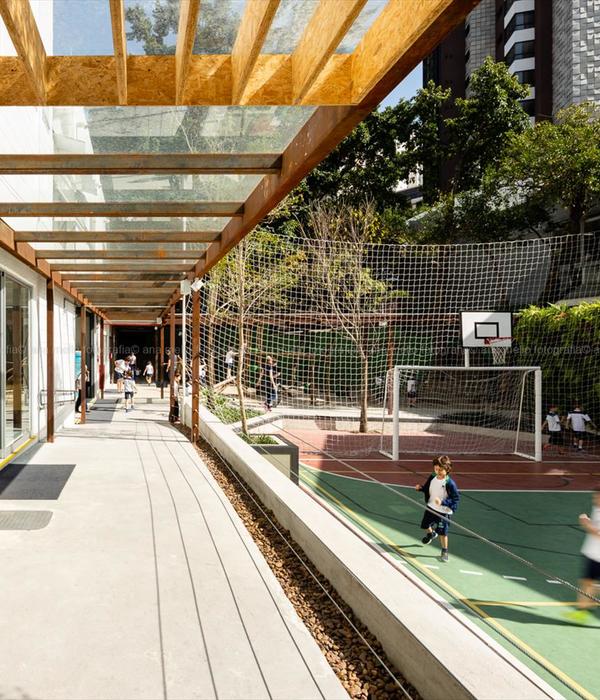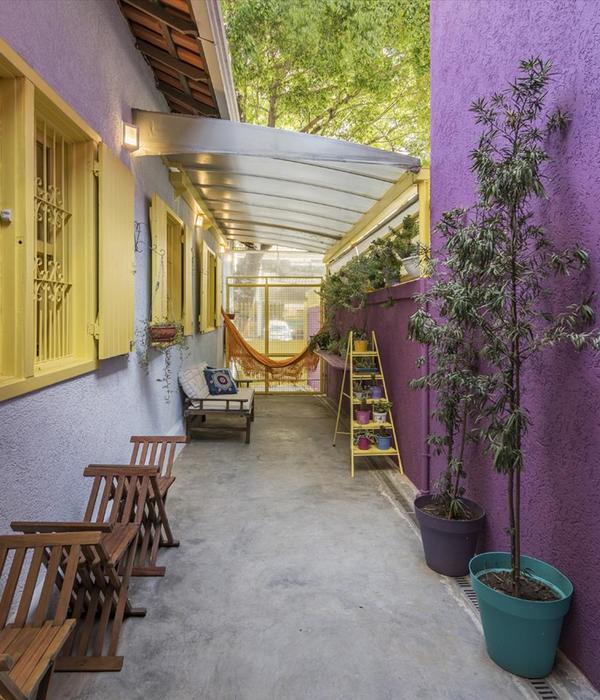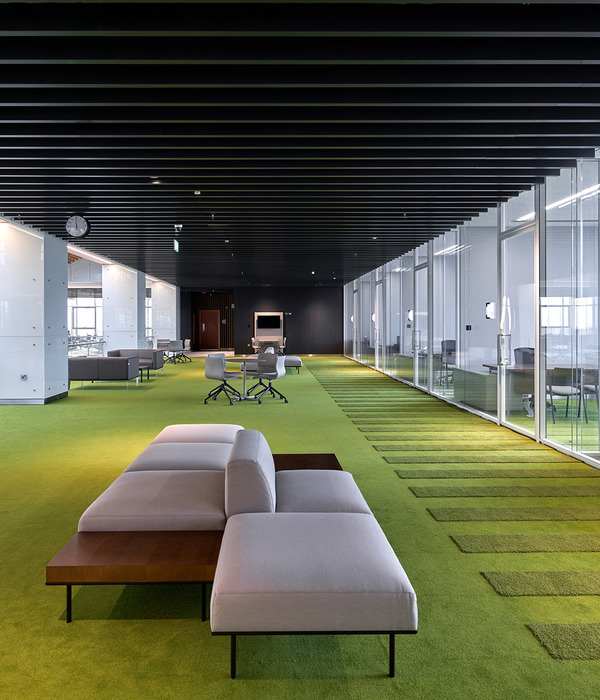“神经元舱(Neuron Pod)”是一个醒目的长23米,高10米的独立结构,作为伦敦大学玛丽皇后学院(Queen Mary University of London)怀特查佩尔(Whitechapel)校区的通用科学学习中心,已于近日正式开放。本项目位于伦敦大学玛丽皇后学院的Blizard研究所(Blizard Institute)内,延续了Blizard研究所理性的设计概念,并作为研究所内一个视觉焦点,向人们展示着研究所正在进行的振奋人心的研究项目。
‘Neuron Pod’ – a striking 23-metre long and 10-metre high free-standing structure – has opened its doors as an informal science learning centre at Queen Mary University of London’s Whitechapel campus. Located in the Blizard Institute mews at Queen Mary University of London, Neuron Pod continues the design rational of the Blizard Institute to act as a visual announcement of the exciting work happening within the institute.
▼神经元舱外观,exterior view of the Neuron Pod ©Jonathan Cole
建筑师通过三根支柱将神经元舱架高于街面之上,使得原先的地面空间仍然可以作为公共空间,同时将舱体的荷载直接转移到街面之下的结构构件上。这就意味着在施工期间,街面之下的敏感医药研究实验室的工作不会被迫中断。神经元舱可以通过现有的水平无障碍步道进入。
By raising Neuron Pod on three legs the mews remains a useable public space and Neuron Pod’s load is transferred directly onto structural elements below the mews. This meant the sensitive medical research labs beneath the mews were not disrupted during the construction. Neuron Pod is accessed via an existing walkway with level, barrier free access.
▼神经元舱外观,三根支柱将其架高于街面之上,exterior view, three legs raise Neuron Pod above the mews ©Jonathan Cole
▼神经元舱外观局部,原先的地面空间仍然可以作为公共空间,partial exterior view, the mews remains a useable public space ©Jonathan Cole
本项目所使用的单壳体结构是在车辆设计中常见的结构技术,同时其钢表皮也起着结构的作用,通过不同的厚度来减轻结构自身的重量,且减少材料的使用和消耗。在现有地下空间不需要加固的情况下,单壳体结构所能承载的最大重量为25吨,因此本项目并不需要额外加建地基基础。神经元舱具有高度隔热的结构,因此,它有着非常低的冷热荷载。建筑师在本项目中使用了一个空气源热泵和热回收通风系统装置,在一年的大部分时间内,它们都能够为舱体降温、同时产生可再生的热能。
The monocoque is a structural technique often seen in vehicle design and the steel skin also acts as the structure, varying in thickness to minimise weight and use of materials. It had a 25 ton maximum weight to ensure that no strengthening was required on the existing basement thereby negating the need for foundations. The heavily insulated structure has a very low heating and cooling load. An air-source heat pump and heat recovery ventilation unit provide free cooling and renewable energy heating to the pod for the majority of the year.
▼神经元舱夜景,使用单壳体结构和钢表皮,night view of the Neuron Pod with the monocoque and the steel skin ©Jonathan Cole
来自Brick Lane基督教会小学的孩子们参加了一场关于“鼻涕、生病和结痂(Snot, Sick and Scabs’)”的互动式生物学科学教育活动,该活动由细胞研究中心(Centre of the Cell),即玛丽皇后学院(Queen Mary)的通用科学学习中心举办。而这一活动的举行,也标志着该中心正式对外开放。自2009年开放以来,细胞研究中心已经制定并推出了一系列独特的教育计划,旨在鼓励学生们将来从事科学事业,并让公众参与到生物医学研究中去,值得一提的是,迄今已经有超过180,000人参与了这个活动。
The launch was marked by a visit from children from Christ Church Primary School, Brick Lane, who took part in an interactive science education activity about the biology of ‘Snot, Sick and Scabs’, run by Centre of the Cell, Queen Mary’s informal science learning centre. Since opening in September 2009, Centre of the Cell has delivered a range of unique educational programmes designed to inspire pupils to pursue a career in the sciences and to engage the public with biomedical research, with more than 180,000 people participating in their activities to date.
▼神经元舱夜景,表皮上配有灯光装置,营造出一种独特的夜间效果,night view of the Neuron Pod with light installations, creating a unique night atmosphere ©Jonathan Cole
神经元舱由已故的Will Alsop OBE RA教授于建筑事务所aLL Design设计完成,值得一提的是,建筑事务所aLL Design也是现有舱体和神经元舱旁边的Blizard研究的设计者,曾获得了众多设计的奖项。神经元舱的外观设计灵感来自于神经细胞的图像,其室内空间的设计则受到其他细胞或分子微粒的启发,由四个小舱体组成。
Neuron Pod is designed by the late Professor Will Alsop OBE RA at aLL Design, creator of the existing Pod and surrounding Blizard Institute, which has won numerous design awards. Its design is inspired by images of a nerve cell, following on from the four pods inside the building that were inspired by other cells or molecules.
伦敦大学玛丽皇后学院细胞研究中心主任Fran Balkwill教授说道:“神经元舱不仅能够激发我们的潜能,更能让来访的游客们受益匪浅。对我们来说,真正重要的是它增强了我们与当地社区之间的联系和互动。神经元舱空间的演变过程令人期待也令人激动,我们希望它能够为人们提供一个可以放任自己进行天马行空的想象的空间。” Professor Fran Balkwill, Director of Centre of the Cell, Queen Mary University of London, said: “Neuron Pod will allow us to fulfill our potential and offer so much more to our visitors. What’s really important to us is that it increases our ability to interact with the local community. It will be exciting to see how this space evolves and we’re hoping it will become a space where people can let their imaginations run riot.”
▼神经元舱夜景及入口,其外观设计灵感来自于神经细胞的图像,night view of the Neuron Pod and its entrance, Neuron Pod’s design is inspired by images of a nerve cell ©Jonathan Cole
这个胚胎形状的结构是世界上首个位于运行中的生物医学研究实验室之内的教育中心。该教育中心致力于尽可能的满足各类需求,不仅提升来访的客流量,更为一系列的科学类现场演出、实践研讨会、实验、讨论会、电影和展览提供了适应性的多功能空间。
Their original embryo-shaped science education centre was the first in the world to be located within working biomedical research laboratories. Planned to address demand, Neuron Pod will help increase visitor numbers, and provide a multi-functional space for live science shows, hands-on workshops, experiments, debates, films and exhibitions.
▼神经元舱夜景局部,入口位于二层,可通过一条平坦的无障碍通道进入,partial night view of the Neuron Pod, its entrance is located at the first floor and accessible through a level, barrier free access ©Jonathan Cole
神经元舱于2018年4月开始建造,需要将13件大型钢材焊接在一起,每件钢材都在泰晤士河边的Dartford Crossing路口进行焊接,甚至,鉴于某些钢材的尺寸过于夸张,施工过程中还邀请了警察进行协助和护送。
Construction of Neuron Pod began in April 2018, which involved welding together 13 large steel sections, each arriving one by one through the Dartford Crossing, with some requiring police escort due to their size.
建筑事务所aLL Design的Marcos Rosello说道:“神经元舱展示了如何通过创造一个令人愉悦、同时具有极强的功能性的物体和空间来将创造力和艺术转化为建筑。非常开心此次能够与细胞研究中心合作,共同进行本项目的设计开发。” Marcos Rosello from aLL Design said: “Neuron Pod shows how you can use creativity and art as architecture by creating an object and space that both delights while being extremely functional. Developing the design alongside the Centre of the Cell team has been a joy.”
▼神经元舱夜景局部,partial night view of Neuron Pod ©Jonathan Cole
神经元舱还将在晚上举办一系列新的成人创意研讨会,同时为针对14-16周岁的年轻人的Key Stage 4和第六届学校访问活动提供场地支持,进一步改善了无障碍通道,此外,还有助于细胞研究中心为学习有困难的年轻人制定专门的课程。除此之外,本项目还计划着通过租赁场地来为社区和企业活动提供场所。
Neuron Pod will also assist in hosting new adult initiatives in the evenings, provide activities for Key Stage 4 (age 14 – 16) and sixth form school visits, improve disabled access, and increase the Centre’s ability to develop programmes for young people with learning difficulties. There are also plans to lease the space for community and corporate events.
2018年4月,在本项目开始施工之际,已故的Will Alsop OBE RA教授曾说道:“很荣幸也很自豪能够有机会为这个令人惊叹的机构奉献自己的一份力量。他们致力于激励年轻一代走上科学研究的道路,令人欣慰的是,至今,他们所做的一切都效果显著。我认为新的舱体将有能力为年轻人提供一种更加积极的空间体验。” Speaking at the start of Neuron Pod’s construction in April 2018, the late Professor Will Alsop OBE RA, said: “I feel proud to have the opportunity to contribute to this amazing institution. Their work in encouraging young people is extraordinary. I think the new pod will help give young people an even more positive experience.”
▼神经元舱外表皮细节,details of the skin of Neuron Pod ©Jonathan Cole
这个斥资200万英镑的项目的投资者包括惠康(Wellcome)、伦敦大学玛利皇后学院、Barts慈善机构(Barts Charity)、沃尔夫森基金会(Wolfson Foundation)、加菲尔德韦斯顿基金会(Garfield Weston Foundation)、布森慈善机构(Hobson Charity)以及戈斯林基金会(Gosling Foundation)等。此外,该项目设计和施工的参与者还包括Total Construction、Littlehampton Welding和AKT II等。
Funders of the £2m project include Wellcome, Queen Mary University of London, Barts Charity, Wolfson Foundation, Garfield Weston Foundation, Hobson Charity and Gosling Foundation. Design and construction also involved Total Construction, Littlehampton Welding and AKT II.
基督教会小学的校长Julian Morant说道:“科学类的课程在我们的课程设置中占据着至关重要的地位,而细胞研究中心恰好正在大力支持这类课程的开设。我们的孩子们非常享受这种学习体验,同时还能够与科学领域内的专家们进行一系列互动,并从中得到灵感和启发。” “最重要的是,这些机会提高了这些孩子们的期望,使他们有了更远大的抱负——他们不再认为科学和医学都是与自己八竿子打不着的东西了。我们希望他们能够认识到,他们可以将科学事业视作自己未来人生的一部分,并为之不断努力。” Julian Morant, Headteacher at Christ Church Primary School said: “Science plays an incredibly important part of our curriculum, which is very much supported by the opportunities that Centre of the Cell provides. The children enjoy the experience immensely, and get inspired by the activities and interactions with experts in the field. “Most importantly, these opportunities are about raising expectations and ambitions in these children – so they don’t see science and medicine as something that only involves other people elsewhere. We want them to realise that a career in science can be part of their future, which they can aspire to and work hard to achieve.”
▼神经元舱室内,可以通过改变灯光的颜色营造不同的光环境氛围,interior view of the Neuron Pod, creating different light environment through changing the color of the light ©Jonathan Cole
Sally从小在伦敦的陶尔哈姆莱茨区(Tower Hamlets)长大,当时11岁的她在细胞研究中心开放后不久便进去进行了参观。八年后,她又作为伦敦大学玛丽皇后学院医学院的一年级新生回到了这里,今天,她作为细胞研究中心学生解说团队中的一员,向游客们讲述着自己鼓舞人心的童年经历。
Sally was raised in Tower Hamlets and first visited Centre of the Cell as an 11 year-old shortly after it opened. Eight years later, she has now returned to Queen Mary University of London as a first year medical student, and is a member of the Centre of the Cell student explainer team, closing the circle on an inspiring childhood experience.
Sally说道:“通过参观细胞研究中心,我发现了科学的真正含义。我意识到自己是真的很喜欢科学,尤其是医学科学。在那之后,我知道了自己将来的人生和职业规划,那就是进入医学领域。我希望这个新的建筑空间能够为更多像我一样的学生们提供机会,为他们提供一个鼓舞人心的体验。” She said: “By going to Centre of the Cell, I found out what science was really about. I realised I actually enjoyed it, and was particularly fascinated by medical science more than other subjects. I then knew that medicine was something I wanted to go into as a career. This new space will hopefully allow many more schoolchildren to have the same inspiring experience that I had.”
▼首层平面图,ground floor plan
▼二层平面图,first floor plan
▼屋顶平面图,roof plan
▼西立面图,west elevation
▼南立面图,south elevation
▼北立面图,north elevation
▼纵向轴测图,long section
▼横向轴测图,short section
{{item.text_origin}}

